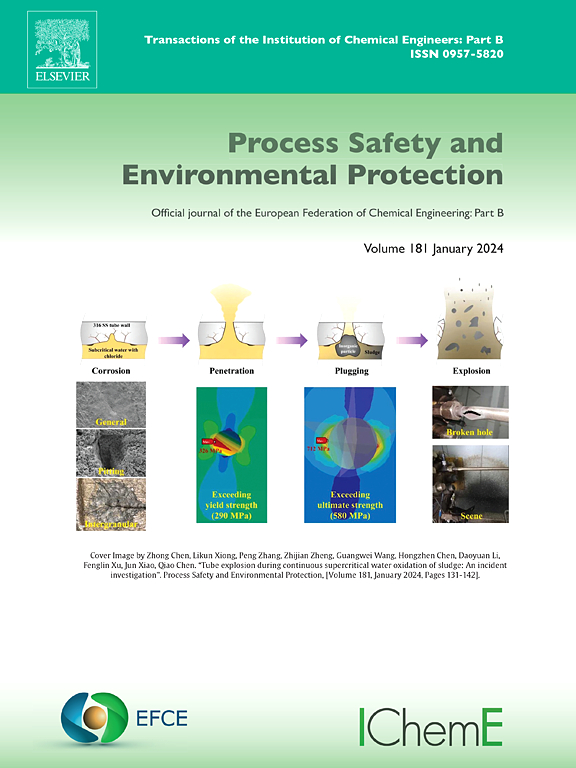基于BO-LightGBM的煤自燃温度预测与风险分类双预警模型
IF 6.9
2区 环境科学与生态学
Q1 ENGINEERING, CHEMICAL
引用次数: 0
摘要
本文建立了基于BO-LightGBM的煤炭自燃温度预测和风险分类双预警模型。通过Pearson相关分析,选择了5种气体特征(O₂、CO、C₂H₄、CO/ΔO₂和C₂H₄/C₂H₆),并定义了6个基于温度的风险等级来表征不同的燃烧阶段。BO-LightGBM模型采用五重交叉验证和早期停止构建,超参数分别优化回归和分类任务。与网格搜索和随机搜索相比,贝叶斯优化显著提高了效率,在回归方面参数优化时间分别缩短了91.2%和60.0%,在分类方面分别缩短了97.9%和85.1%。性能对比进一步验证了BO-LightGBM的优越性。该模型在回归任务中的MAE为10.9844,MAPE为7.57,RMSE为22.5728,R²为0.9129,在分类任务中准确率为90.00 %,召回率为0.9000,精度为0.8920,F1得分为0.8959。结果表明,BO-LightGBM在预测精度和计算效率方面均具有显著优势,为煤矿自燃风险评估提供了可靠的预警工具。本文章由计算机程序翻译,如有差异,请以英文原文为准。
Dual-warning model for coal spontaneous combustion temperature prediction and risk classification based on BO-LightGBM
This study develops a dual-warning model for coal spontaneous combustion temperature prediction and risk classification based on BO-LightGBM. Five gas features (O₂, CO, C₂H₄, CO/ΔO₂, and C₂H₄/C₂H₆) were selected via Pearson correlation analysis, and six temperature-based risk levels were defined to characterize different combustion stages. The BO-LightGBM model was constructed using five-fold cross-validation and early stopping, with hyperparameters optimized separately for regression and classification tasks. Compared with grid search and random search, Bayesian Optimization significantly improved efficiency—reducing parameter optimization time by 91.2 % and 60.0 % in regression, and by 97.9 % and 85.1 % in classification, respectively. Performance comparisons further validate the superiority of BO-LightGBM. The model yielded a MAE of 10.9844, a MAPE of 7.57, a RMSE of 22.5728, and an R² of 0.9129 in regression tasks, and achieved an accuracy of 90.00 percent, a recall of 0.9000, a precision of 0.8920, and an F1 score of 0.8959 in classification tasks. These results confirm that BO-LightGBM offers notable advantages in both predictive accuracy and computational efficiency, providing a reliable early warning tool for spontaneous combustion risk assessment in coal mines.
求助全文
通过发布文献求助,成功后即可免费获取论文全文。
去求助
来源期刊

Process Safety and Environmental Protection
环境科学-工程:化工
CiteScore
11.40
自引率
15.40%
发文量
929
审稿时长
8.0 months
期刊介绍:
The Process Safety and Environmental Protection (PSEP) journal is a leading international publication that focuses on the publication of high-quality, original research papers in the field of engineering, specifically those related to the safety of industrial processes and environmental protection. The journal encourages submissions that present new developments in safety and environmental aspects, particularly those that show how research findings can be applied in process engineering design and practice.
PSEP is particularly interested in research that brings fresh perspectives to established engineering principles, identifies unsolved problems, or suggests directions for future research. The journal also values contributions that push the boundaries of traditional engineering and welcomes multidisciplinary papers.
PSEP's articles are abstracted and indexed by a range of databases and services, which helps to ensure that the journal's research is accessible and recognized in the academic and professional communities. These databases include ANTE, Chemical Abstracts, Chemical Hazards in Industry, Current Contents, Elsevier Engineering Information database, Pascal Francis, Web of Science, Scopus, Engineering Information Database EnCompass LIT (Elsevier), and INSPEC. This wide coverage facilitates the dissemination of the journal's content to a global audience interested in process safety and environmental engineering.
 求助内容:
求助内容: 应助结果提醒方式:
应助结果提醒方式:


